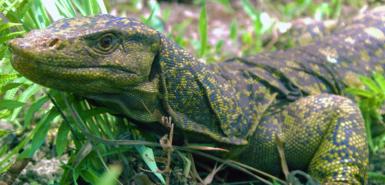
April 6, 2010

A dragon-sized, fruit-eating lizard (genus Varanus) that was ethnoknown to locals but unknown to Western science has been discovered on the northern Philippines island of Luzon. Scientists have confirmed it as a new species, on Tuesday, April 6, 2010.

The two meter-long Varanus bitatawa was found by University of Kansas students during an expedition during the summer of 2009 to the heavily populated and largely deforested Luzon Island. DNA testing has placed the fruit-eating species in the Komodo dragon family. The discovery was described as an “unprecedented surprise” by scientists documenting the find in the Royal Society’s Biology Letters journal.
The brightly colored forest monitor lizard can grow to more than six feet in length but weighs only about 22 pounds (10 kg), said Rafe Brown of the University of Kansas, whose team confirmed the find.
“It lives up in trees, so it can’t get as massive as the Komodo dragon, a huge thing that eats large amounts of fresh meat,” Brown said by telephone. “This thing is a fruit-eater and it’s only the third fruit-eating lizard in the world.”
Discovering such a large vertebrate species is extremely rare, Brown said. The lizard, a new species of the genus Varanus, is skittish and able to hide from humans, its primary predators, which could explain why it has gone undetected by scientists for so long.
Biologists first saw photographs of the big, skinny lizard in 2001, when those surveying the area passed hunters carrying the lizards’ colorful carcasses, but the species at that point had never been given a scientific identification.
In the next few years, Brown said, ethnobiologists kept hearing stories “about these two kinds of lizard that everyone liked to eat because their flesh tasted better than the ones that lived on the ground; this thing was described as bigger and more brightly colored.”
The two kinds of lizard described by the local people were two names for the same animal, Brown said.
In 2009, graduate students at the end of a two-month expedition kept seeing signs of the big lizard. There were claw-scratches on trees and clumps of pandanus trees, whose fruit the lizard prefers.
The clumps indicated that the lizards had eaten pandanus fruit and then excreted the seeds in clusters.
“It was literally in the last couple days of the expedition, we were running out of money and food and this was the payoff: they finally got this gigantic animal,” Brown said.
Hunters who had heard of the team’s interest brought a barely-alive adult male lizard to their camp. The team euthanized the animal and did genetic tests that confirmed it as a unique species, Brown said.
DNA analysis showed there was a deep genetic divergence between the new lizard and its closest relative, Gray’s monitor lizard, which is also a fruit-eater but lives on the southern end of Luzon, rather than the northern end where the forest monitor lizard lives.
“They are extremely secretive,” Brown said of the new species. “I think that centuries of humans hunting them have made the existing populations … very skittish and wary and we never see them. They see and hear us before we have a chance to see them, they scamper up trees before we have a chance to come around.”
These findings were published in the Royal Society Journal Biology Letters, with additional work by scientists in the Philippines and the Netherlands.
About Loren Coleman
Loren Coleman is one of the world’s leading cryptozoologists, some say “the” leading living cryptozoologist. Certainly, he is acknowledged as the current living American researcher and writer who has most popularized cryptozoology in the late 20th and early 21st centuries.
Starting his fieldwork and investigations in 1960, after traveling and trekking extensively in pursuit of cryptozoological mysteries, Coleman began writing to share his experiences in 1969. An honorary member of Ivan T. Sanderson’s Society for the Investigation of the Unexplained in the 1970s, Coleman has been bestowed with similar honorary memberships of the North Idaho College Cryptozoology Club in 1983, and in subsequent years, that of the British Columbia Scientific Cryptozoology Club, CryptoSafari International, and other international organizations. He was also a Life Member and Benefactor of the International Society of Cryptozoology (now-defunct).
Loren Coleman’s daily blog, as a member of the Cryptomundo Team, served as an ongoing avenue of communication for the ever-growing body of cryptozoo news from 2005 through 2013. He returned as an infrequent contributor beginning Halloween week of 2015.
Coleman is the founder in 2003, and current director of the International Cryptozoology Museum in Portland, Maine.
Filed under Breaking News, Classic Animals of Discovery, CryptoZoo News, Giant Cryptid Reptiles, New Species